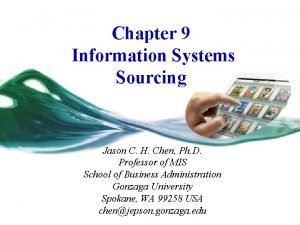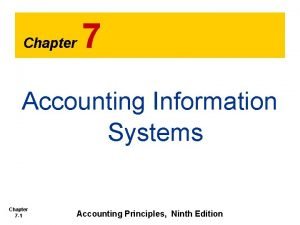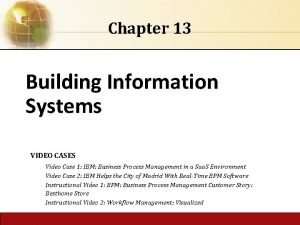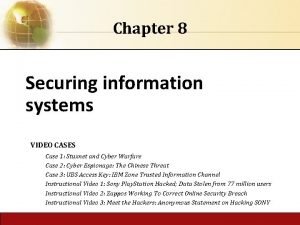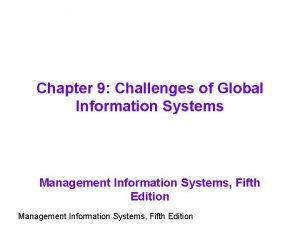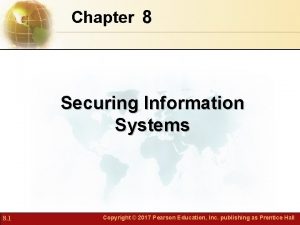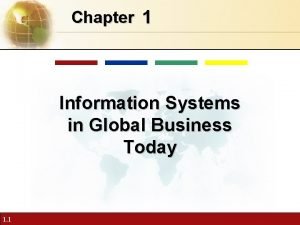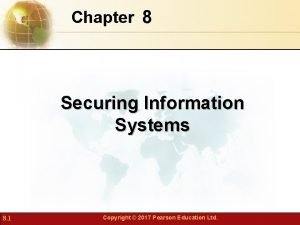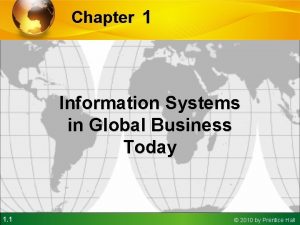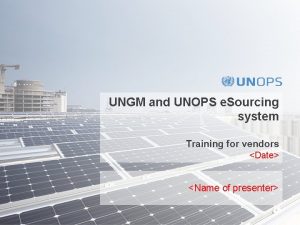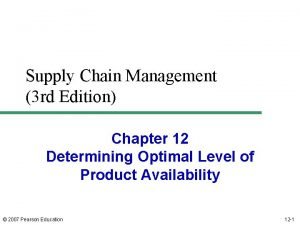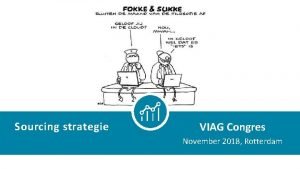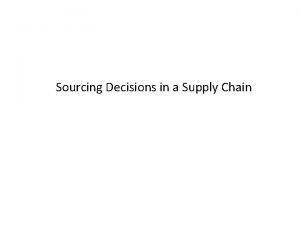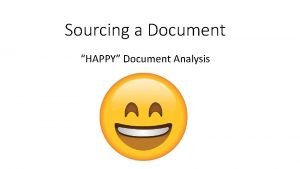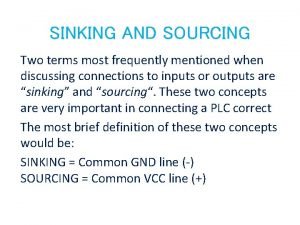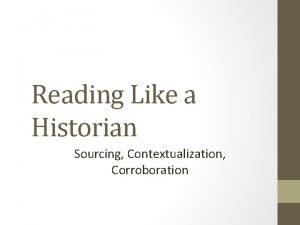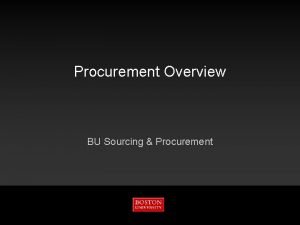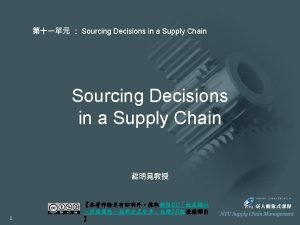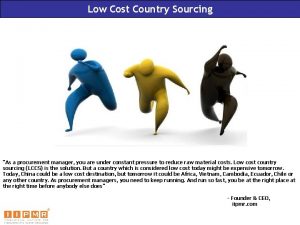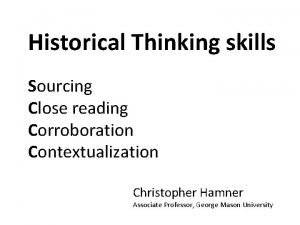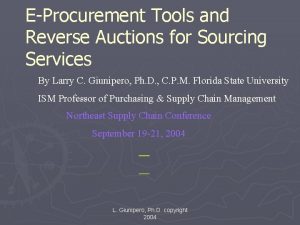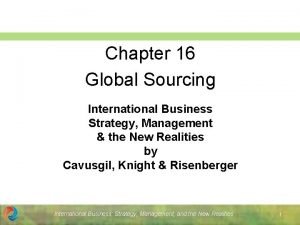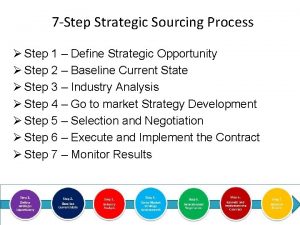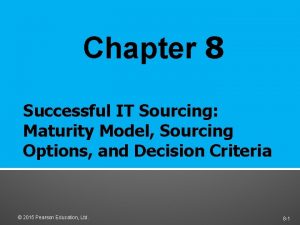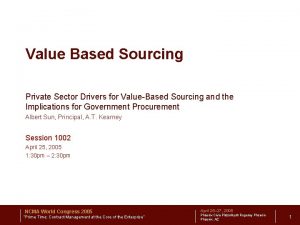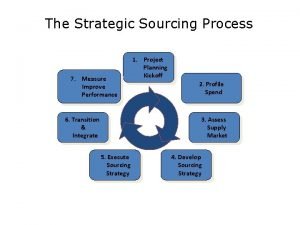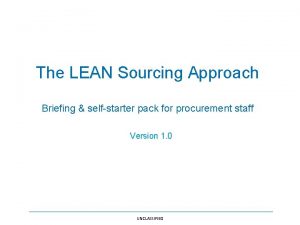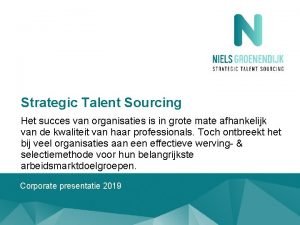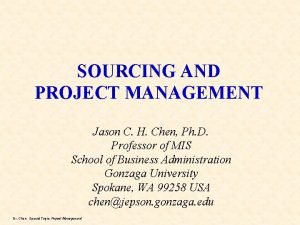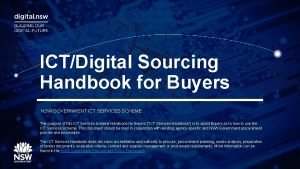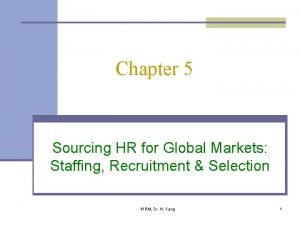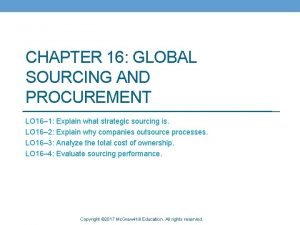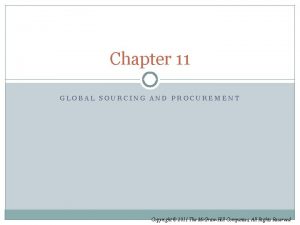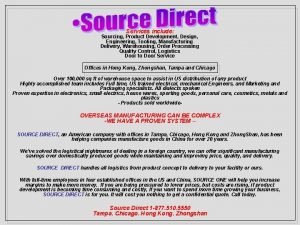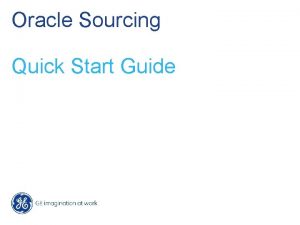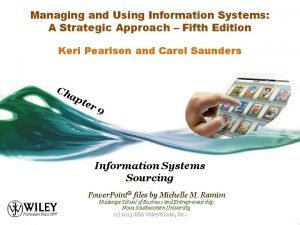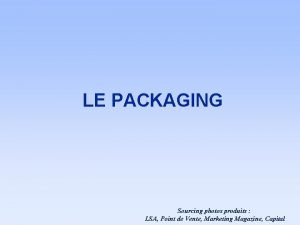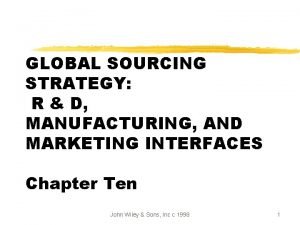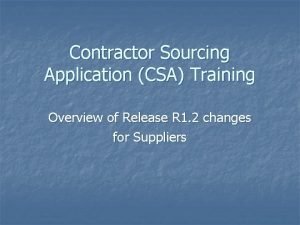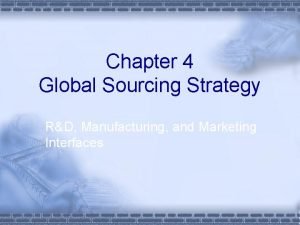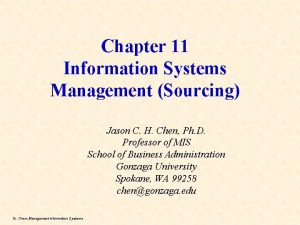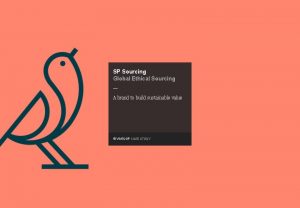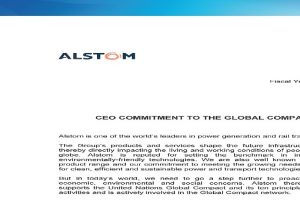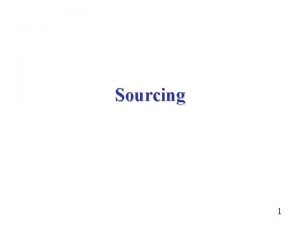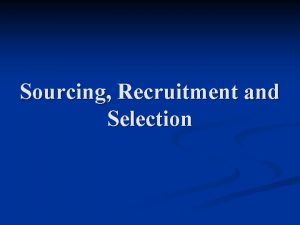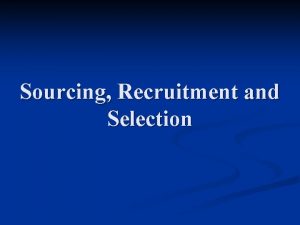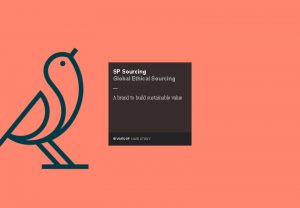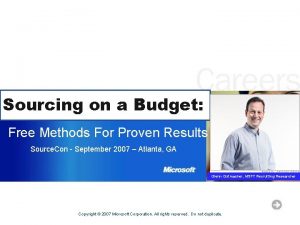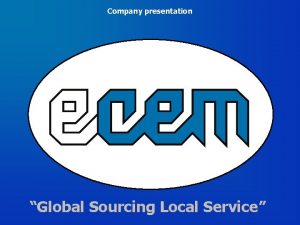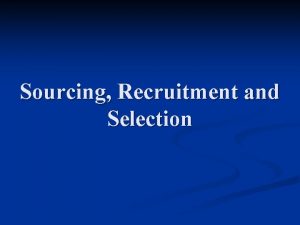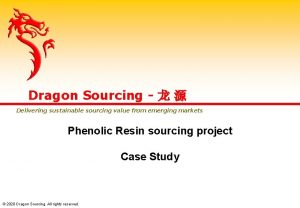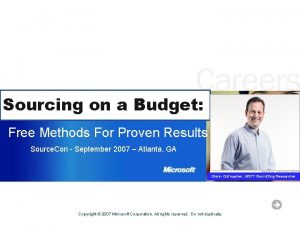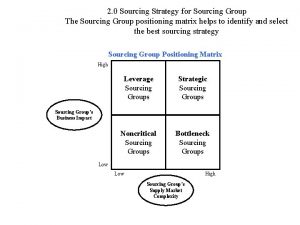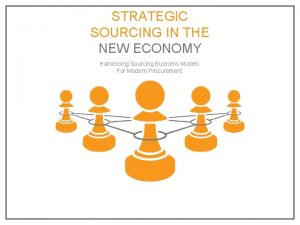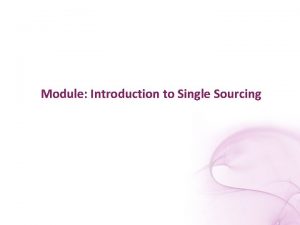Chapter 9 Information Systems Sourcing Jason C H






























































- Slides: 62

Chapter 9 Information Systems Sourcing Jason C. H. Chen, Ph. D. Professor of MIS School of Business Administration Gonzaga University Spokane, WA 99258 USA chen@jepson. gonzaga. edu

Learning Objectives • Describe the Sourcing Decision Cycle Framework. • Explain the differences between insourcing and outsourcing, inshoring and offshoring, and nearshoring and farshoring. • List the major drivers for outsourcing. • Describe how offshoring must be managed. • Define the different ways of outsourcing including ASPs. • Understand the difference between full and selective outsourcing. • Describe the risks and strategies utilized to mitigate risks. ã John Wiley & Sons, Inc. & Dr. Chen, Information Systems – Theory and Practices 2

Real World Example • Kellwood, an American apparel maker, ended its soup-to-nuts IS outsourcing arrangement with EDS after 13 years. • The original outsourcing contract integrated 12 individual acquired units with different systems into one system. • In 2008, Sun Capital Partners purchased Kellwood and made it private. • The COO was facing a mountain of debt and possibly bankruptcy and wanted to: – bring the IS operations back in-house. – reduce costs. – overcome the lack of IS standardization. • The CIO was concerned that the transition from outsourcing to insourcing would cause serious disruption to IS service levels and project deadlines. ã John Wiley & Sons, Inc. & Dr. Chen, Information Systems – Theory and Practices 3

Real World Example (Cont. ) • Kellwood hired a third-party consultant. Backsourcing would help save money and respond to changes • ______ caused by both the market and internal forces. • The transition and the implementation went smoothly. • By performing streamlined operations in-house, it was able to report an impressive 17% savings in annual IS expenses after the first year. • Companies adopt outsourcing as means of controlling IS costs and acquiring “best of breed” capabilities. • IS departments must maximize the benefit of these relationships to the enterprise and preempt problems that might occur. • Failure could result in deteriorating quality of service, loss of competitive advantage, costly contract disputes, low morale, and loss of key personnel. ã John Wiley & Sons, Inc. & Dr. Chen, Information Systems – Theory and Practices 4

Discussion Question • #1. The make-versus-buy decision is important every time a new application is requested of the IS group. What, in your opinion, are the key reasons an IS organization should make its own systems? What are the key reasons it should buy an application? [MAKE-versus-BUY] ã John Wiley & Sons, Inc. & Dr. Chen, Information Systems – Theory and Practices 5

• Per the text, the key drivers to insource (Make) are: – Good for core competencies; – Good for confidential or sensitive IS services or software development; – Time available in-house to complete software development projects; – In-house IT professionals have adequate training, experience or skills to provide service or develop software. • The buy decision will also depend upon things such as cost, availability of resources (human, technical, etc. ), and other drivers. Per the text the drivers are: – – – – Offers costs savings; Eases transition to new technologies; Offers opportunity for better strategic focus; Provides better management of IS staff; Offers better ability to handle peaks; Makes it easier to consolidate data centers; Provides a cash-infusion ã John Wiley & Sons, Inc. & Dr. Chen, Information Systems – Theory and Practices 6

Key Drivers Competitive Market • It is a very competitive for any businesses competing in a global market. quality (or satisfaction) Cost (profit) and ______ • _____ are key drivers in this market place. • Porter’s five competitive forces model apply as external influences on the company, but are in sufficient alone to inform the company in the market place. • Why? Source: Knowledge: the key to organisational survival, Raeside and Walker – The TQM Magazine, Vol. 13, 2001 ã John Wiley & Sons, Inc. & Dr. Chen, Information Systems – Theory and Practices 7

Internal Forces • To Porter’s model, the following five internal forces should be added (4 C’s and 1 Q): – – – Customer focuses; Communications; Core competencies; Complexity; and Quality Source: Knowledge: the key to organisational survival, Raeside and Walker – The TQM Magazine, Vol. 13, 2001 ã John Wiley & Sons, Inc. & Dr. Chen, Information Systems – Theory and Practices 8

PORTER’S FIVE COMPETITIVE FORCES MODEL NEW MARKET ENTRANTS Internal Forces: 1. customer focus 2. communication 3. core competencies 4. complexity 5. Quality SUBSTITUTE PRODUCTS & SERVICES Threats INDUSTRY COMPETITORS THE FIRM • Cost-effectiveness • Market access • Differentiation of product or service SUPPLIERS Bargaining power ã John Wiley. Dr. & Sons, Dr. Chen, Information Theory and Practices Chen, Inc. The&Trends of the Information. Systems –Technology Other forces should be considered in the e -Age: 1. Digitalization 2. Globalization 3. Deregulation/ liberalization CUSTOMERS 9 TM -9 N

SOURCING DECISION CYCLE FRAMEWORK ã John Wiley & Sons, Inc. & Dr. Chen, Information Systems – Theory and Practices 10

Sourcing Decision Cycle Framework • Sourcing involves many decisions (Figure 9. 1). make or ____ buy decision. • The first step is the _____ – If the “buy” option is selected, the company outsources. – The company must decide on “how” and “where. ” – Is the outsourcing provider in its own country, offshore, or in the cloud? – If the company decides to offshore, it must decide whether to offshore nearby or far away. • Periodically must evaluate the arrangement and adjust it. • Continual evaluation is needed to determine if the arrangement is satisfactory or not—either for outsourcing or insourcing. ã John Wiley & Sons, Inc. & Dr. Chen, Information Systems – Theory and Practices 11

HOW & WHERE the sourcing should be delivered? Where Abroad? (overseas subsidiary) (distant land) Where? (proximate) How? BUY /ONSHORING 1 a- new? 1 b-new? MAKE CLOUD 1 c-new? 2. Backsourcing FIGURE 9. 1 SOURCING DECISION CYCLE FRAMEWORK ã John Wiley & Sons, Inc. & Dr. Chen, Information Systems – Theory and Practices 12

INSOURCING ã John Wiley & Sons, Inc. & Dr. Chen, Information Systems – Theory and Practices 13

Insourcing • A firm provides IS services or develops IS in its own in -house IS organization. make ” decision. • This is the “_____ • Drivers that favor this decision: – Keep core ___ competencies ______in-house. – IS service or product that requires considerable security or confidentiality. – Time available in-house to complete IS projects. – In-house IT personnel. • Challenges to insourcing (Figure 9. 2 and 9. 2(b)): – Getting needed IT resources from management. – Finding a reliable competent outsource provider. ã John Wiley & Sons, Inc. & Dr. Chen, Information Systems – Theory and Practices 14

Figure 9. 2 Make or buy? Questions and risks. ã John Wiley & Sons, Inc. & Dr. Chen, Information Systems – Theory and Practices 15

Insourcing Drivers Insourcing Challenges core competencies Good for _________ Dealing with Inadequate support from top management Good for confidential or sensitive to acquire needed resources IS services or software due to lack of expertise of development knowing the complexity of the projects etc. Time available in-house to complete software development Finding a reliable, competent outsourcing provider that is projects likely to stay in business In-house IT professionals have they are in the consulting adequate training, experience or industry. skills to provide service or develop software Figure 9. 2(b) Insourcing drivers and challenges ã John Wiley & Sons, Inc. & Dr. Chen, Information Systems – Theory and Practices 16

INSOURCING What is the example(s) mentioned in the Friedman’s Video (The World is Flat)? ã John Wiley & Sons, Inc. & Dr. Chen, Information Systems – Theory and Practices 17

OUTSOURCING ã John Wiley & Sons, Inc. & Dr. Chen, Information Systems – Theory and Practices 18

OUTSOURCING • What company was the first one propose/promote the concept of Outsourcing? And When? Andersen in 1972 • Ans: Author _____________ ã John Wiley & Sons, Inc. & Dr. Chen, Information Systems – Theory and Practices 19

Outsourcing • The phenomenon that appeared in the information outsourcing systems field in the late 1980 s was______, which means turning over a firm's computer operations, network operations, or perhaps other information systems functions to a vendor for a three years. specified time - generally, at least for _____ • “…IT outsourcing is a harbinger of traditional IT department transformation and provides a glimpse at the emerging organizational structures of the information economy. “ • Definition: The purchase of a good or service that was previously provided internally, or that could be provided internally but is now provided by outside vendors. ã Chen, John Wiley & Sons, Inc. & Thru Dr. Chen, Information Systems – Theory and Practices Dr. Managing IT Reos. Strategic Partnerships; A Portoflio Approach to IT Development 20 TM -20

Outsourcing (cont. ) • Drivers include: üReducing costs; üTransition to new technologies; üFocus on core business strategies; üProvide better management and focus of IT personnel. • Disadvantages are present in outsourcing and include ü Losing control, ü Expensive to undue decisions, etc. • Backsourcing is when a company brings back previously outsourced IS functions. • Outsourcing has expanded to include essential functions such as customer service and other aspects that provide competitive advantage. ã John Wiley & Sons, Inc. & Dr. Chen, Information Systems – Theory and Practices 21

Outsourcing As an Economic Strategy • • • Core competencies _______ less expensive Which sources are _____ control is needed How much _______ ã John Wiley & Sons, Inc. & Dr. Chen, Information Systems – Theory and Practices 22

The Driving Forces Behind Outsourcing • Two main drivers focus – _____ • on core business value – _____ • stakeholder ã Chen, John Wiley & Sons, Inc. & Thru Dr. Chen, Information Systems – Theory and Practices Dr. Managing IT Reos. Strategic Partnerships; A Portoflio Approach to IT Development 23 TM -23

Outsourcing Models Classic model • _____ • Outsource only those functions that do not give the company competitive advantage (prevailing method of the 70 s and 80 s). Kodak effect” • The “____ – Kodak outsourced its data center operations to IBM and its desktop supply and support operations to Businessland. – Kodak retained a skeleton IS staff. – Kodak’s approach to supplier management became a model emulated by Continental Bank, General Dynamics, Continental Airlines, National Car Rental, etc. – Eastman Kodak Filed for Bankruptcy on Jan. 19, 2012. (Why? ) • New models: – Full vs. Selective (strategic sourcing) Outsourcing: complete outsourcing vs. only outsourcing specific functions and Cloud computing 24 ã John Wiley & Sons, Inc. & Dr. Chen, Information Systems – Theory and Practices

Single vs. Multiple Vendors • Pros/cons between these two options? • Multiple vendors allows client companies to distribute work to the “best in breed. ” coordination – Requires more ______. – If problems may be a tendency to finger point. riskier • Single vendor model is simpler but _______. – Only one company to coordinate. – All IS “eggs” are in one basket. ã John Wiley & Sons, Inc. & Dr. Chen, Information Systems – Theory and Practices 25

Decisions about How to Outsource Successfully • The decision about whether or not to outsource must be made with adequate care and deliberation. • Requires numerous other decisions about mitigating outsourcing risks. – Three major decision areas: selection, contracting, and scope. 1. Selection • Focuses on finding compatible providers whose capabilities, managers, internal operations, and culture complement those of the client. – Compatibility and cultural fit may trump price. 2. Contracting • Many “how” decisions center around the outsourcing contract. – Ensure that contract terms allow flexibility to manage and, if necessary, sever supplier relationships. ã John Wiley & Sons, Inc. & Dr. Chen, Information Systems – Theory and Practices 26

Decisions about How to Outsource Successfully (cont. ) 2. Contracting (cont. ) • Shorter duration contracts. – Between three to five years. – Full life-cycle service contracts are broken up into stages. • Service Level Agreements (SLAs) define the level of service between the clients and providers such as: – delivery time and expected performance of the service. – actions to be taken in the event of a deterioration in quality of service or non-compliance to service-level agreements. – service levels, baseline period measurements, growth rates, and service volume fluctuations. • Research demonstrates that tighter contracts tend to lead to more successful outsourcing arrangements. 3. Scope • Client must decide whether to pursue outsourcing fully or selectively. ã John Wiley & Sons, Inc. & Dr. Chen, Information Systems – Theory and Practices 27

Full versus Selective Outsourcing • Full outsourcing implies that an enterprise outsources all its IS functions from desktop services to software development. • Selective outsourcing—or strategic sourcing - an enterprise chooses which IT capabilities to retain inhouse and which to give to an outsider. • In a “best-of-breed” approach, suppliers are chosen for their expertise in specific technology areas such as: – Website hosting, Web 2. 0 applications, business process application development, help desk support, networking and communications, social IT services, and data center operations. ã John Wiley & Sons, Inc. & Dr. Chen, Information Systems – Theory and Practices 28

Deciding Where Onshore, Offshore, or in the Cloud? • Previously outsourcing options were either to onshore (same country as the use services ____ client) or _______ offshore (a distant country). • New sourcing option: cloud computing. • Comparison of the three sourcing options (Figure 9. 3). ã John Wiley & Sons, Inc. & Dr. Chen, Information Systems – Theory and Practices 29

Figure 9. 3 Trade-offs between outsourcing options. ã John Wiley & Sons, Inc. & Dr. Chen, Information Systems – Theory and Practices 30

Figure 9. 3 Trade-offs between outsourcing options (cont. ) ã John Wiley & Sons, Inc. & Dr. Chen, Information Systems – Theory and Practices 31

Cloud Computing • Cloud computing: – A third party provides IT services over the Internet. – Provides an entire data center’s worth of servers, networking devices, systems management, security, storage, and other infrastructure. • Clients buy the exact amount of storage, computing power, security, or other IT functions they need, when they need it, and pay only for what they use. – Cost saving. • 24/7 access from multiple mobile devices. – High availability for large backup data storage. – Ease of use. ã John Wiley & Sons, Inc. & Dr. Chen, Information Systems – Theory and Practices 32

Cloud Computing Options • Cloud computing options: – On-premise. – Private clouds. • Data is managed by the company and remains within the company’s existing infrastructure, or it is managed offsite by a third party. – Community clouds. • The cloud infrastructure is shared by several organizations and supports the shared concerns of a specific community. – Public clouds. • Data is stored outside of the corporate data centers in the cloud provider’s environment. – Hybrid clouds. – Combination of two or more other clouds. ã John Wiley & Sons, Inc. & Dr. Chen, Information Systems – Theory and Practices 33

Public Clouds Characteristics • Infrastructure as a Service (Iaa. S). – Provides infrastructure through grids or clusters or virtualized servers, networks, storage, and systems software. – Designed to augment or replace the functions of an entire data center. – The customer may have full control of the actual server configuration. • More risk management control over the data and environment. • Platform as a Service (Paa. S). – Provides services using virtualized servers on which clients can run existing applications or develop new ones without having to worry about maintaining the operating systems, server hardware, load balancing, or computing capacity. – Provider manages the hardware and underlying operating system. – Limits the enterprise risk management capabilities. ã John Wiley & Sons, Inc. & Dr. Chen, Information Systems – Theory and Practices 34

Public Clouds Characteristics (cont. ) • Software as a Service (Saa. S) or Application Service Provider (ASP). – Software application functionality through a web browser. – The platform and infrastructure are fully managed by the cloud provider. – If the operating system or underlying service isn’t configured correctly, the data at the higher application layer may be at risk. – The most widely known and used form of cloud computing. • Some managers shy away from cloud computing because they are concerned about: – security—specifically about external threats from remote hackers and security breaches as the data travels to and from the cloud. – data privacy. ã John Wiley & Sons, Inc. & Dr. Chen, Information Systems – Theory and Practices 35

Onshoring • Onshoring, or inshoring, is performing outsourcing work domestically. • Onshoring may be considered the opposite of offshoring. • Rural sourcing, hiring outsourcing providers with operations in rural parts of America, is a growing trend. – Lower salaries and living costs. – A closer time zone, similar culture, and fewer hassles that crop up when dealing with foreign outsourcing providers. – Too small to handle large-scale projects. – May not have the most technologically advanced employees (Figure 9. 4). ã John Wiley & Sons, Inc. & Dr. Chen, Information Systems – Theory and Practices 36

Figure 9. 4 Government involvement with offshoring. ã John Wiley & Sons, Inc. & Dr. Chen, Information Systems – Theory and Practices 37

OUTSOURCING ABROAD ã John Wiley & Sons, Inc. & Dr. Chen, Information Systems – Theory and Practices 38

Going Offshore for IS Development • When the MIS organization uses contractor services, or even builds its own data center in a distant land, it is offshoring , which is short for outsourcing engaged in _____ offshore. • The types of tasks that are outsourced are usually those that can be well-specified; however, nowdays, the functions sent offshore range from routine IT transactions to increasingly higher end, knowledgebased processes. • Countries such as India, the Philippines, etc, offer “offshoring”, an alternative to in-house systems development • It raises the issue of what to send offshore, and what to keep within your enterprise MIS organization. ã John Wiley & Sons, Inc. & Dr. Chen, Information Systems – Theory and Practices 39

Offshoring • Offshoring (or outsourcing offshore) - the IS organization uses contractor services or even builds its own data center in a distant land. • Functions range from routine IT transactions to increasingly higher -end, knowledge-based business processes. • Programmer salaries can be a fraction of those in the home country. – Other costs increase due to additional technology, telecommunications, travel, process changes, and management overhead. • Other reasons to offshore: – Employees in many offshore companies are well-educated (have master’s degrees) and are proud to work for an international company. – Offshore providers are often “profit centers” and have established Six Sigma, ISO 9001, or another certification program. ã John Wiley & Sons, Inc. & Dr. Chen, Information Systems – Theory and Practices 40

Deciding Where Abroad: Nearshoring, Farshoring, or Captive Center? • Offshoring can be either relatively proximate (nearshoring) or in a distant land (farshoring). • An alternative to offshoring is a captive center. • Farshoring is a form of offshoring that involves sourcing service work to a foreign, lower-wage country that is relatively far away in distance or time zone (or both). – India and China are the most popular farshoring destinations. • Nearshoring is when work is sourced to a foreign, lower-wage country that is relatively close in distance or time zone. • The client hopes to benefit from one or more ways of being close—geographically, temporally, culturally, linguistically, economically, politically, or from historical linkages. ã John Wiley & Sons, Inc. & Dr. Chen, Information Systems – Theory and Practices 41

Captive Centers • A captive center is an overseas subsidiary that is set up to serve the parent company. • These subsidiaries operate like an outsourcing provider but are owned by the firm. • Hybrid and shared. – The hybrid captive center performs the more expensive, higher-profile or mission-critical work for the parent company. • Outsources the more commoditized work that is more cheaply provided by an offshore provider. – The shared captive center performs work for both a parent company and external customers. • Nearshore or farshore. ã John Wiley & Sons, Inc. & Dr. Chen, Information Systems – Theory and Practices 42

Selecting an Offshore Destination: Answering the “Where Abroad? ” Question • Deciding where to offshore is a difficult decision that many companies face. attractiveness level of development, • Companies must consider _______, differences and culture _______. – Factors affecting a country’s attractiveness: • • • high English proficiency, on the verge of war. high rates of crime. friendly relationships with the home country. regulatory restrictions. Three tiers of level of trade issues. development: data security. Tier 1: Mature (highest) intellectual property. Tier 2: Emerging level of technical infrastructure available. Tier 3: Infant ã John Wiley & Sons, Inc. & Dr. Chen, Information Systems – Theory and Practices 43

Offshore Destination - Development Tiers Carmel and Tjia suggest that there are three tiers (level of development) of software exporting nations: • Tier 1: Mature (the highest tier) – United Kingdom, United States, Japan, Germany, France, Canada, the Netherlands, Sweden, Finland, India, Ireland, Israel, China, and Russia. • Tier 2: Emerging. – Brazil, Costa Rica, South Korea, and many Eastern European countries. • Tier 3: Infant. – • • Cuba, Vietnam, Jordan, and 15 to 25 others. Tiers were determined based on industrial maturity, the extent of clustering of some critical mass of software enterprises, and export revenues. The higher tiered countries have higher levels of skills and higher costs. ã John Wiley & Sons, Inc. & Dr. Chen, Information Systems – Theory and Practices 44

Cultural Differences • Misunderstandings arise because of differences in culture, language, and perceptions about time. • Carmel and Tjia outlined some examples of communication failures with Indian developers: – Indians are less likely than Westerners to engage in small talk. – Indians often are not concerned with deadlines. – Indians, like Malaysians and other cultures, are hesitant no about saying _____. – What is funny in one culture is not necessarily funny in another culture. ã John Wiley & Sons, Inc. & Dr. Chen, Information Systems – Theory and Practices 45

Reevaluation—Status Quo or Change? • Backsourcing ______ is a business practice in which a company takes back in-house assets, activities, and skills that were part of its IS operations and were previously outsourced to one or more outside IS providers. • Companies backsource after terminating, renegotiating, or letting their contracts expire. • The reasons given for backsourcing often mirror the reasons for outsourcing. • Outsourcing decisions can be difficult and expensive to reverse. – Requires the enterprise to acquire the necessary infrastructure and staff. • Backsourcing is followed by another cycle of decisions as the company responds to its dynamic environment. ã John Wiley & Sons, Inc. & Dr. Chen, Information Systems – Theory and Practices 46

Outsourcing and Strategic Networks • Many issues and risks are involved with outsourcing. • A strategic network is a long-term, purposeful arrangement by which companies set up a web of close relationships that provide a product or service in a coordinated fashion. • The client becomes a hub with suppliers as part of its network. • Lowers the cost of working with others in the network. • Company can become more efficient than its competitors (and very flexible). • The Japanese keiretsu is similar to a strategic network. – The Japanese companies manage their outsourcing activities based on the types of inputs from different types of suppliers. ã John Wiley & Sons, Inc. & Dr. Chen, Information Systems – Theory and Practices 47

Additional Strategic Networks • Another type of strategic network is one with a parent organization or multinational and a number of their subsidiaries. • Often one subsidiary performs outsourcing services for another subsidiary in the network. • Given the increasingly complex structure of today’s multinationals, the role of strategic networks in outsourcing arrangements is likely to grow (Figure 9. 5). ã John Wiley & Sons, Inc. & Dr. Chen, Information Systems – Theory and Practices 48

Outsourcing and Strategic Networks A strategic network is a long-term, purposeful arrangement by which companies set up a web of close relationships that provide a product or service in a coordinated fashion. Given the increasingly complex structure of today’s multinationals, the role of grow (Figure 9. 5). strategic networks in outsourcing arrangements is likely to ______ Figure 9. 5 Sourcing options. ã John Wiley & Sons, Inc. & Dr. Chen, Information Systems – Theory and Practices 49

Crowdsourcing • Definition: – 1) Taking a task traditionally performed by an employee or contractor, and outsourcing it to an undefined, generally large group open call people , in the form of an _____ of ______ – 2) The dynamic SM process of employing users to participate in product design or product redesign. • E. g. e. Bay often solicits customers to provide feedback on their e. Bay experience. • Other examples? • Wikipedia and PSY Horse Dance • Used by companies to increase productivity, lower production costs, and fill skill gaps. • Can be used for a variety of tasks. • Companies do not have control over the people doing the work. • Has cost more than traditional methods. 50 ã John Wiley & Sons, Inc. & Dr. Chen, Information Systems – Theory and Practices

Why Outsourcing Alliances are So Difficult? • Exacerbating the situation is the timing of benefits – – – Customer ______ Outsourcer ______ and their perspective/interests are conflict or reverse • Only a few outsourcers have the critical mass and access to capital markets to undertake large contracts • Evolution of technologies often changes the strategic relevance of IT service to a firm. ã John Wiley & Sons, Inc. & Dr. Chen, Information Systems – Theory and Practices 51

The Expanding Scope of Vendor Options • • • To buy professional services To buy a product To buy a transaction To use a systems integrator - project based Outsourcing - time based Cost Speed Capacity Quality Reliability Products/ Services ã John Wiley & Sons, Inc. & Dr. Chen, Information Systems – Theory and Practices Expertise 52

When to Outsourcing? • Which IS activities are strategic to our company's business? 15 percent? • Will outsourcing save us at least ____ • Does our firm have access to the needed technology and expertise? – If not, outsourcing may be the answer to acquiring these resources. • Does outsourcing increase our firm's flexibility? ã Chen, John Wiley & Sons, Inc. & Thru Dr. Chen, Information Systems – Theory and Practices Dr. Managing IT Reos. Strategic Partnerships; A Portoflio Approach to IT Development 53 TM -53

What Activities that Management should not Outsource? Strategy ____ Policy role ______ the decisions about when to introduce information systems into the organization • the management of the vendor • when the system (IS) department is well managed, and where IT is a core competency • • • ã Chen, John Wiley & Sons, Inc. & Thru Dr. Chen, Information Systems – Theory and Practices Dr. Managing IT Reos. Strategic Partnerships; A Portoflio Approach to IT Development 54 TM -54

Outsourcing Recommendations 5 years • Write shorter contracts - less than ____ • Subcontract control • Selective outsourcing ã John Wiley & Sons, Inc. & Dr. Chen, Information Systems – Theory and Practices 55

Figure 9. Extra-1 Outsourcing Drivers and challenges Outsourcing Drivers Outsourcing Challenges Offer cost saving Abdication of control Ease transition to new technologies Lack of technology innovation Offer opportunity for better strategic Loss of strategic advantage focus Provide better management of IS staff Reliance on outsourcer Offer better ability to handle peaks Make it easier to consolidate data center Provide a cash infusion ã John Wiley & Sons, Inc. & Dr. Chen, Information Systems – Theory and Practices Mitigating outsourcing risks Ensuring cost savings while protecting quality Working effectively with suppliers 56

Fig. 9. Extra-2: Avoiding Outsourcing Pitfalls price • Do not negotiate solely on _____ • Craft full life-cycle service contracts that occur in stages. • Establish short-term supplier contracts. • Use multiple, best-of-breed suppliers. • Develop skills in contract management. • Carefully evaluate your company’s own capabilities. • Thoroughly evaluate outsourcing providers’ capabilities. • Choose an outsourcing provider whose capabilities complement yours. • Base a choice on cultural fit as well as technical expertise. • Determine whether a particular outsourcing relationship produces a net benefit for your company. • Plan transition to offshoring. • Use SOAs to increase agility. ã John Wiley & Sons, Inc. & Dr. Chen, Information Systems – Theory and Practices 57

Patterns of Market Exchange The Trend is From … • Vertical _______integration to • Selective sourcing • Virtual corporation, • Disintermediation of distribution and supply channels • Outsourcing/ Offshoring ã John Sons, Inc. &of. Dr. Information Systems – Theory and Practices Dr. Wiley Chen, &The Trends the. Chen, Information Systems Technology N 58 TM -58

Strategic Grid for Decisions on Outsourcing Strategic Importance Y N Competitive Advantage Y N ã John Wiley & Sons, Inc. & Dr. Chen, Information Systems – Theory and Practices 59

Strategic Grid for Decisions on Outsourcing Strategic Importance Competitive Advantage Y N Insourcing Leverage Strategic Alliance ã John Wiley & Sons, Inc. & Dr. Chen, Information Systems – Theory and Practices (K-How to partners) Outsourcing 60

Summary: Factors driving outsourcing 1. Cost savings 2. Qualified IT staff are difficult to find and retain 3. By bringing in outside expertise, management needs to focus less on IS operations and more on the information itself. 4. Outsourcers are specialists, should understand how to manage IS staff more effectively. 5. Outsourcers may have larger IS resources that provide greater capacity on demand. 6. Outsourcing can help a company overcome inertia to consolidate data centers that could not be consolidated by an internal group, or following a merger or acquisition. ã John Wiley & Sons, Inc. & Dr. Chen, Information Systems – Theory and Practices 61

Summary • Firms typically face a range of sourcing decisions. • Cost savings or filling the gaps in the organization’s IT skills are powerful drivers for outsourcing. • Offshoring may be performed in a country that is proximate along one or a number of dimensions (nearshoring) or that is distant (farshoring). • Different ways of outsourcing include cloud computing and crowdsourcing. • Full or selective outsourcing offers organizations an alternative to keeping top-performing IS services inhouse. ã John Wiley & Sons, Inc. & Dr. Chen, Information Systems – Theory and Practices 62
 Reactive sourcing
Reactive sourcing Sourcing decision cycle framework
Sourcing decision cycle framework Management information systems chapter 1
Management information systems chapter 1 Chapter 8 securing information systems
Chapter 8 securing information systems Chapter 8 securing information systems
Chapter 8 securing information systems Chapter 7 accounting information systems
Chapter 7 accounting information systems Chapter 7 accounting information systems
Chapter 7 accounting information systems Dfd chapter 13
Dfd chapter 13 Securing information systems
Securing information systems White-collar workers คือ
White-collar workers คือ Fundamentals of information systems
Fundamentals of information systems Global information management
Global information management Chapter 8 securing information systems
Chapter 8 securing information systems Chapter 4 ethical and social issues in information systems
Chapter 4 ethical and social issues in information systems Information systems in global business today
Information systems in global business today Introduction to management information system
Introduction to management information system Chapter 4 ethical and social issues in information systems
Chapter 4 ethical and social issues in information systems Chapter 8 securing information systems
Chapter 8 securing information systems Chapter 7 accounting information systems
Chapter 7 accounting information systems Chapter 3 information systems organizations and strategy
Chapter 3 information systems organizations and strategy Information systems in global business today
Information systems in global business today Unops e sourcing
Unops e sourcing Esourcing unops
Esourcing unops Tailored sourcing supply chain
Tailored sourcing supply chain Telecom sourcingstrategie
Telecom sourcingstrategie Capacity aggregation supply chain
Capacity aggregation supply chain Sourcing decision cycle framework
Sourcing decision cycle framework Happy document analysis chart
Happy document analysis chart Sourcing and sinking
Sourcing and sinking Direct material sourcing and quoting
Direct material sourcing and quoting Sourcing contextualization corroboration
Sourcing contextualization corroboration Bu procurement
Bu procurement Role of sourcing in supply chain
Role of sourcing in supply chain Low cost country sourcing
Low cost country sourcing Sourcing corroboration contextualization
Sourcing corroboration contextualization Reverse image
Reverse image Global sourcing in international business
Global sourcing in international business Active pharmaceutical intermediates
Active pharmaceutical intermediates 7 step sourcing
7 step sourcing Ariba rfq
Ariba rfq Sourcing maturity model
Sourcing maturity model Value based sourcing
Value based sourcing 7 step strategic sourcing process
7 step strategic sourcing process Lean sourcing
Lean sourcing Werksts
Werksts Sourcing decision cycle framework
Sourcing decision cycle framework Global sourcing partners
Global sourcing partners Global sourcing conference
Global sourcing conference Ict strategic sourcing
Ict strategic sourcing Determinants of staffing choices
Determinants of staffing choices Sourcing/purchasing design matrix
Sourcing/purchasing design matrix Sourcing/purchasing design matrix
Sourcing/purchasing design matrix Tooling sourcing
Tooling sourcing Product availability meaning
Product availability meaning Oracle negotiation strategy
Oracle negotiation strategy What is batna
What is batna Sourcing decision cycle framework
Sourcing decision cycle framework Sourcing packaging
Sourcing packaging Content sourcing strategy
Content sourcing strategy Contractor sourcing application
Contractor sourcing application Contractor sourcing application
Contractor sourcing application Risks of e procurement
Risks of e procurement Advantages and disadvantages of global sourcing
Advantages and disadvantages of global sourcing

